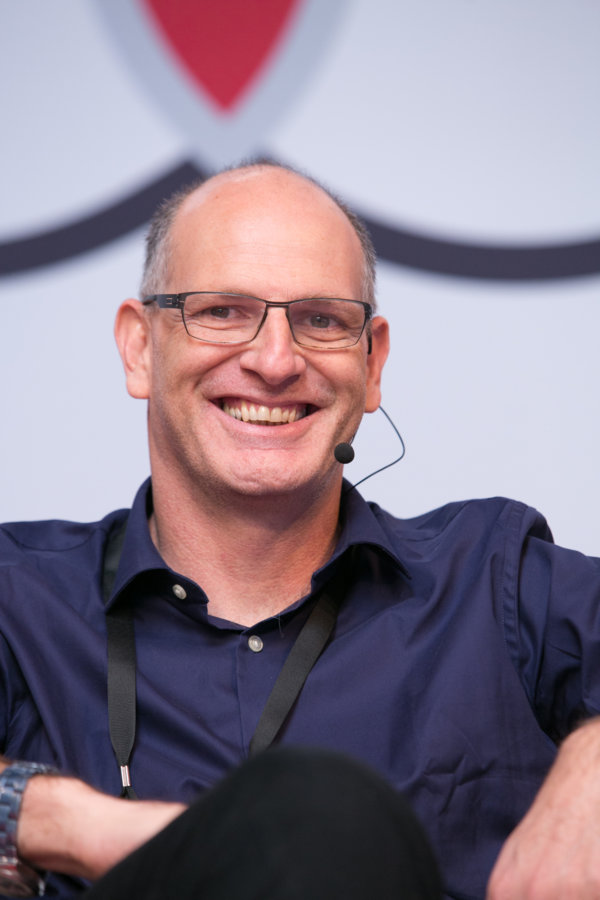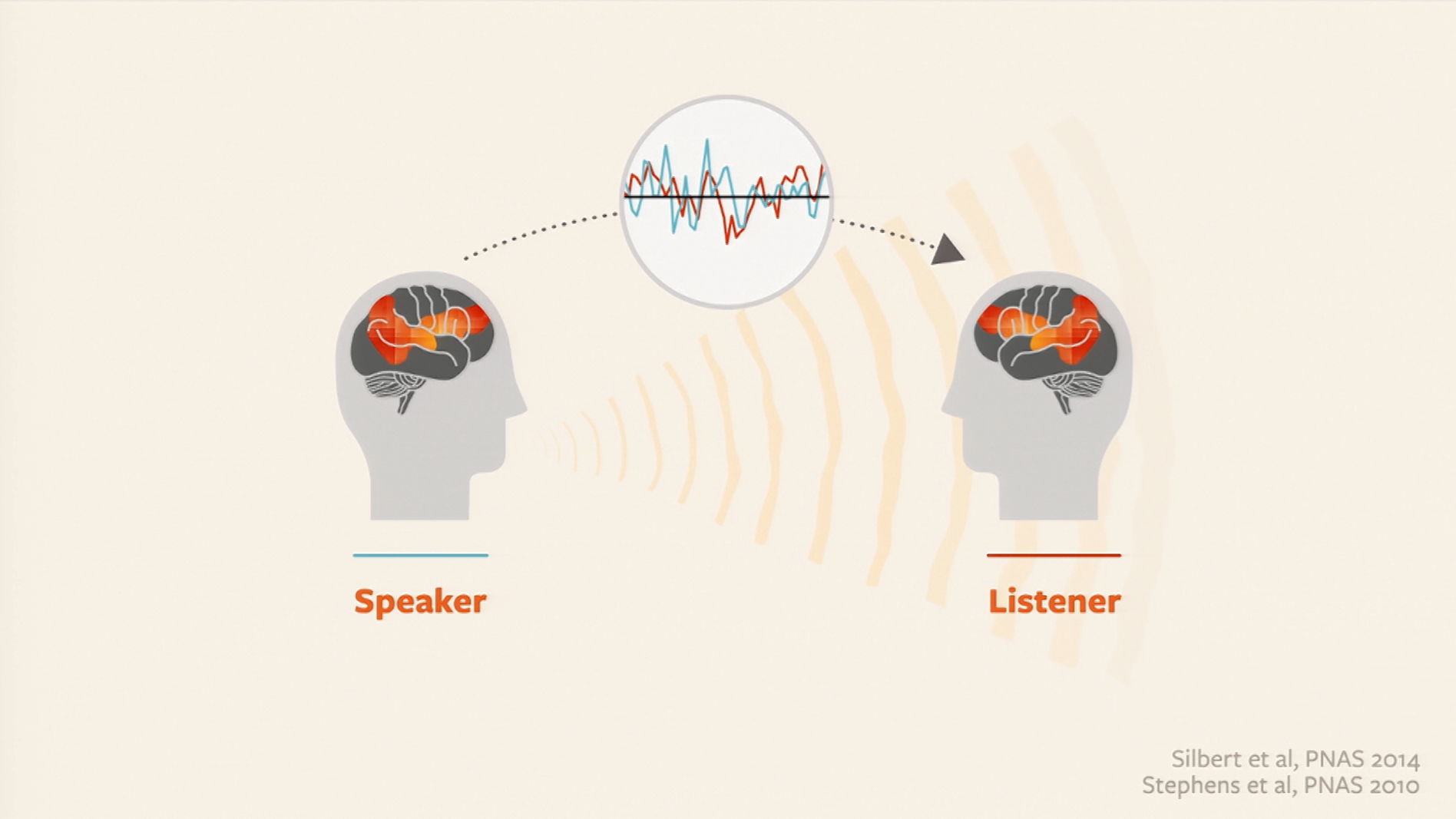By Zara Houshmand
 Uri Hasson
Uri HassonUri Hasson’s research investigates how people’s brain responses are shaped by their interaction with others, especially through the medium of language. Language defines our relationship to community and serves as the mechanism to transfer knowledge across generations. The existence of language depends on a community of speakers, and when knowledge is transferred from one person to another, their brains become coupled in a process called neural entrainment.
You tell your kids to choose their friends carefully, because their friends will determine who they themselves are going to be.
Hasson showed how entrainment works as a physical phenomenon: several metronomes clicking out of phase become synchronized over time as their momentum generates a small frequency in the board supporting them. A similar coupling happens between human brains. When a mother and infant make sounds together playfully, spontaneously vocalizing in unison, we see the entrainment that lays the ground for language learning through the mimicking of words and sentences.
Hasson described a study where five people listened to a storyteller’s recording while their brains were scanned in an fMRI machine. The patterns of their neural activity were all very different during silence, but came into alignment with each other as they listened to the story. This entrainment occurred even across the listeners’ different functional brain regions, areas that process auditory information, language, and higher-order thought.
When the experiment was repeated with the audio played backwards so that the sounds were meaningless, only the auditory areas in the listeners’ brains became coupled. When isolated words were used, the early language areas became aligned, with other language processing areas coming into play when scrambled sentence fragments were used. When the story was told in translation to people who speak different languages, their higher-order thought areas became aligned, but not the auditory cortex, which was processing very different sounds. This neural entrainment among listeners is driven by the fact that they are each coupled to the same source of information: the storyteller’s voice. When communication happens successfully, a similar coupling occurs between the speaker’s and listeners’ brains.

Slide: Uri Hasson
But the coupling process that enables communication can also be distorted to segregate people into in-group and out-group. The prior knowledge that people bring to a situation creates filters that interfere with entrainment and lead to the same information being interpreted differently. Hasson described an experiment where half of the listeners were primed with additional background information—“the wife had an affair”—that led them to interpret the same story very differently. Each group became entrained separately though they listened to the same story. In this way, external information—which may or may not be reliable—filters our reality and defines our in-group.
If a story that is open to different interpretations concerns important social and political issues, we become polarized by our entrainment with the people who surround us and the media we consume. There are groups who stand to gain power from the tension, conflict, and violence this polarization creates, and they use ideology as a filter to amplify difference. Ubuntu may serve as a philosophy to bring us together while still accepting differences of opinion. “I am because you are” embraces both the uniqueness of “I” and “you” as well as our mutual connection.
DISCUSSION
Uri Hasson’s presentation sparked a discussion responding to the paradox that ubuntu, with its potential for healing divisions in African society, coexists with the reality of tribal warfare and genocide. Mhondoro Mandaza focused on the impulse to forgive that expresses ubuntu as an expanding mutuality, captured in the Lord’s Prayer’s “forgive us as we forgive others,” and the empathy to see others as ourselves. In response, Michael Eze explained that “I am because you are” is not equivalent to “we.” The individual does not dissolve in the communal, but experiences an expansion of boundaries to include others—not only the in-group but strangers too, those we like and those we don’t like, as well as animals and nature—as an integral part of one’s own existence. Although ubuntu is seen as a noble character value, it does not exclude human failings or any kind of difference from its embrace. Its dynamic nature, and its ability to accommodate differences, mean that the constantly recreated self in interaction with others has the potential to evolve into a new humanity.
Eze also distinguished between ethnicity, which in Africa tends to be fluid and dynamic with overlapping multi-lingual identities, and the tribalism that has become rigid and politicized, in part as a result of colonialism. Tribal identities are now being manipulated by demagogues, and conflict is arising for ideological purposes rather than the competition for limited resources to serve basic needs. Carsten de Dreu noted that the “basic needs” that drive conflict with other groups may also include the desire for status and love within one’s group.
Is it possible to change our predilection for conflict between our own group and others? Rebecca Shansky asked Hasson how persistent the effects were of entrainment that divided groups based on their priming with different background information. Would the group members sense that affiliation, even subtly, if they came together a month later? Hasson observed that in real life the priming may be as pervasive as constant exposure over years to Fox News as a source of information; almost all communication contains ambiguity that will be interpreted differently depending on our background views. Thupten Jinpa identified two avenues that could change our tendency to see differences as sources of conflict. Self-interest is a powerful motive that can lead to adopting new social and cultural phenomena, such as mindfulness, and bring us to the common ground of shared experience with others. The formal, institutional embodiment of an ideal, such as the concept of human rights, is another powerful force for change.
